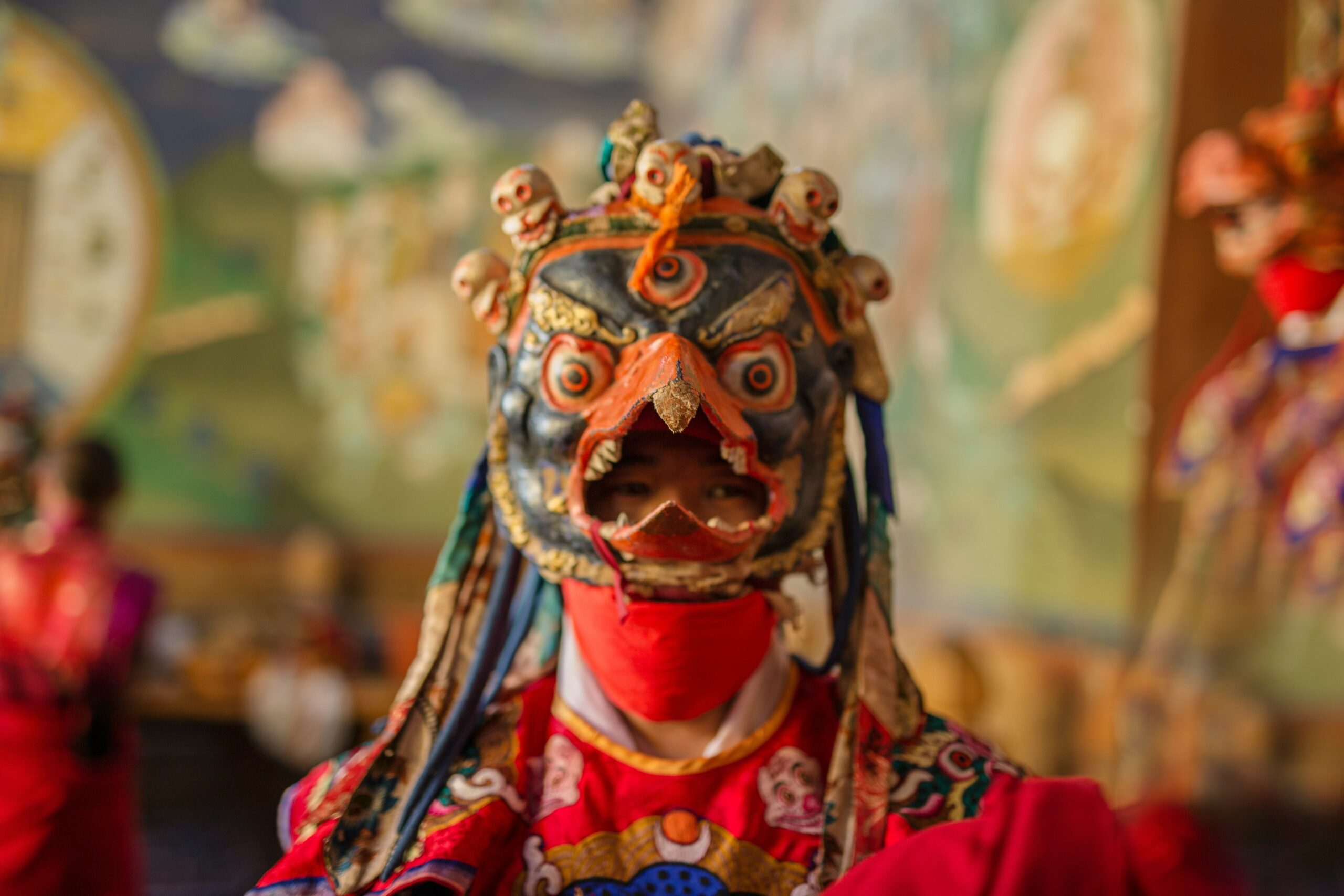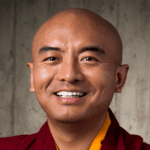A prominent philosopher described our current era as the “age of anxiety.” There’s no doubt the world is filled with fear and uncertainty these days, but from the 2,500-year-old perspective of Buddhism, every period of human history could be seen in the same way. Anxiety is part of the human condition. We human beings are rarely at peace with what’s happening within and around us. Either we try to escape it, or we indulge our impulses, but our reactions often lead to more problems, more stress, and more anxiety.
Buddhism offers another way to live. Instead of the endless push-pull of avoidance and indulgence, we can try a third path: we can look directly at our disturbing emotions and problems, transforming them into stepping stones on the path of liberation.
“The practice in Vajrayana isn’t about creating something new, but about removing all the mental and emotional habits that keep us from experiencing our buddhanature.”
Many people today are looking for new ways to deal with stress, loneliness, and emotional pain. My own journey has shown me that the difficulties we face can become opportunities for awakening. When I embarked on a wandering retreat, leaving the privileged life of a Rinpoche, I immediately encountered fear, sickness, and a near-death experience. Yet, these very challenges became opportunities to work with my mind and deepen my commitment to transforming adversity into awakening.
Pure Perception and Taking Fruition as Path
Vajrayana, which translates to the “indestructible vehicle,” aims to transcend concepts, beyond subject and object, and to cut through the solid and independent self. The fundamental principle here is pure perception, also known as “taking fruition as path.”
What does this mean, pure perception? It means recognizing that you’re a buddha right now, right here. This enlightened nature, also called buddhanature, is always present within us. The challenge is that it’s obscured. The practice in Vajrayana isn’t about creating something new, but about removing all the mental and emotional habits that keep us from experiencing our buddhanature.
Pure perception means seeing beyond our usual biases, unconscious beliefs, and the mistaken idea that things are solid and inherently real. When we perceive things as solid, real, and separate, that’s what we call “impure perception.” But if we recognize their empty, luminous nature, then everything appears as pure. This view serves as the very foundation for all our Vajrayana practices.
Poison Becomes Medicine: Transforming Our Kleshas
Usually, when we encounter disturbing emotions, or kleshas (such as ignorance, aversion, craving, pride, and jealousy), and the suffering they cause (like panic, depression, loneliness, and stress), our instinct is to remove them or use antidotes. For example, if you feel anger, you might try to replace it with loving kindness; if you experience craving, you might practice detachment.
These methods may be helpful, but in Vajrayana, we go a step further. We adopt a transformative and transcendent approach. Instead of simply removing the problem, we realize that the problem itself can become medicine.
Let’s take anger as an example again. If you experience anger, you can look at the nature of anger itself. The essence of anger, when understood correctly, is “mirror-like wisdom.” It has a lot of clarity, energy, and vividness. You can use anger as a support for your meditation. When you observe anger, you are stepping out of its control. It’s like watching a movie; when you watch a movie, you’re not in the movie. This act of seeing is liberation —freedom. The disturbing emotion, when seen for what it is —an expression of the mind’s infinite potential— becomes a support for your path.
This applies to all disturbing emotions and even physical suffering. When I was young, I experienced intense panic attacks. I wanted to get rid of them; I hated them. However, Saljey Rinpoche, one of my most important teachers, taught me that the fear of panic was often stronger than the panic itself. He encouraged me to see my emotional storms as evidence of my mind’s power. The path is not about eliminating suffering, but about correctly perceiving reality. Suffering, even natural suffering such as illness, arises from a misperception in the mind. My father, Tulku Urgyen Rinpoche, would often say, “For the yogi, sickness is a pleasure and death is good news”. This seemingly radical statement points to the truth that the process of physical dissolution, whether through illness or death, can effortlessly uncover our naked awareness and inherent buddhanature.
This transformative process means that nothing in our life, past or present, is beyond purification. Consider the powerful story of Angulimala, a notorious figure during the Buddha’s time. He had brutally killed 999 people, yet even the immense harm of his actions did not have the power to define his ultimate nature. After encountering the Buddha and his wisdom, he became a monk and transformed his immense guilt and shame into profound wisdom and compassion. This incredible example demonstrates that there is no such thing as absolute negativity; every seemingly negative act or experience holds within it the seed of purification. We utilize whatever we have, even our past negative deeds, as an invaluable source for transformation on our path.
Integrating Vajrayana Practice into Everyday Life
What makes the practices within Vajrayana even more profound is that they are designed to be integrated into every aspect of our lives, bringing the view of pure perception into our direct experience in our modern lives. Throughout the teachings, there are various methods that we can learn to realize our innate nature:
- Development Stage Practices: This involves using imagination. We constantly imagine things throughout our daily lives — whether planning a meal, commuting, or recalling the past. In practice, we use the power of the imagination to envision ourselves as a buddha. This combines both shamatha (calm abiding) and vipashyana (insight). We direct our awareness to an inspiring image (shamatha) while simultaneously understanding that it is “not real,” like a moon’s reflection on a lake (vipassana). The purpose is always the benefit of all beings, activating pure perception through imagination.
- Completion Stage Practices: This involves working with the subtle body. Our gross physical body is only one layer; beneath it is a subtle body that holds unconscious patterns, emotional memories, and trauma. This subtle body is active during dreams and plays a significant role in non-verbal communication and learning. Practices in the completion stage work directly with these subtle energies.
- Guru Principle: A profound method to bring pure perception to an experiential level is through the guru principle. Initially, we may project all enlightened qualities onto a guru figure. However, the ultimate realization is that the guru, the student, and all beings share this very same enlightened nature. In other words, the “outer guru” puts us in touch with the “inner guru” —our own buddha nature.
- Path of Liberation: Practice traditions such as Mahamudra and Dzogchen, where the primary aim is to directly recognize and experience the innate wisdom, awareness, love, and compassion that are always present within us.
By practicing the authentic Vajrayana teachings from an authentic lineage, we can infuse pure perception into everyday life situations. Through this personal transformation, there is no limit to how we can benefit the world. For example, seeing the basic innate goodness manifesting in people greatly enhances our communication and relationships. I often find that 99% of the time, I don’t have problems with people because I see the good in them. Even when people complain extensively, if you listen carefully, they often already possess the solution within their complaints. Recognizing and affirming their ideas, rather than imposing our own, can solve many problems.
Ultimately, learning and applying these ancient wisdom practices provides a powerful alternative to the anxiety that characterizes modern life. Instead of perpetuating the cycle of fear and uncertainty by either avoiding our difficult experiences or giving in to our impulses, we can choose a third path. This path invites us to look directly at our anxiety and other challenging emotions, transforming them into the very means of our liberation. By delving deeper into our own nature, we discover the authentic and lasting well-being that has always resided within us, freeing our minds and developing a profound sense of contentment and joy that transcends the anxieties of any age.


